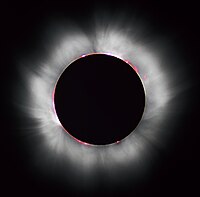
Photo from wikipedia
The E‐region equatorial electric field (EEF) modulates distributions in the ionosphere at equatorial and low latitudes via the fountain effect. Using Swarm data during the daytime and geomagnetically quiet periods… Click to show full abstract
The E‐region equatorial electric field (EEF) modulates distributions in the ionosphere at equatorial and low latitudes via the fountain effect. Using Swarm data during the daytime and geomagnetically quiet periods (Kp ≤ 3), we perform a detailed analysis of the main wave sources of the longitudinal structures of the EEF (LSEEF) in different seasons by fitting the LSEEF with longitudinal wavenumber 1–4 patterns (WN1–WN4), and further matching the dominant tides and stationary planetary waves. The results indicate that: (a) Although the LSEEF exhibit significant seasonal dependence, a prominent one‐peaked structure exists in all seasons (peak: 90°E–120°E; trough: 30°W–70°W). (b) WN1 (WN4) contributes most to the LSEEF over four seasons (spring to autumn) with fractions of 26%–39% (25%–38%). (c) The main wave sources of the LSEEF are DW2 (DE3 and DE2; DE3; DW2 and SW4) in spring (summer; autumn; winter) with each contribution exceeding 15%.
Journal Title: Geophysical Research Letters
Year Published: 2021
Link to full text (if available)
Share on Social Media: Sign Up to like & get
recommendations!